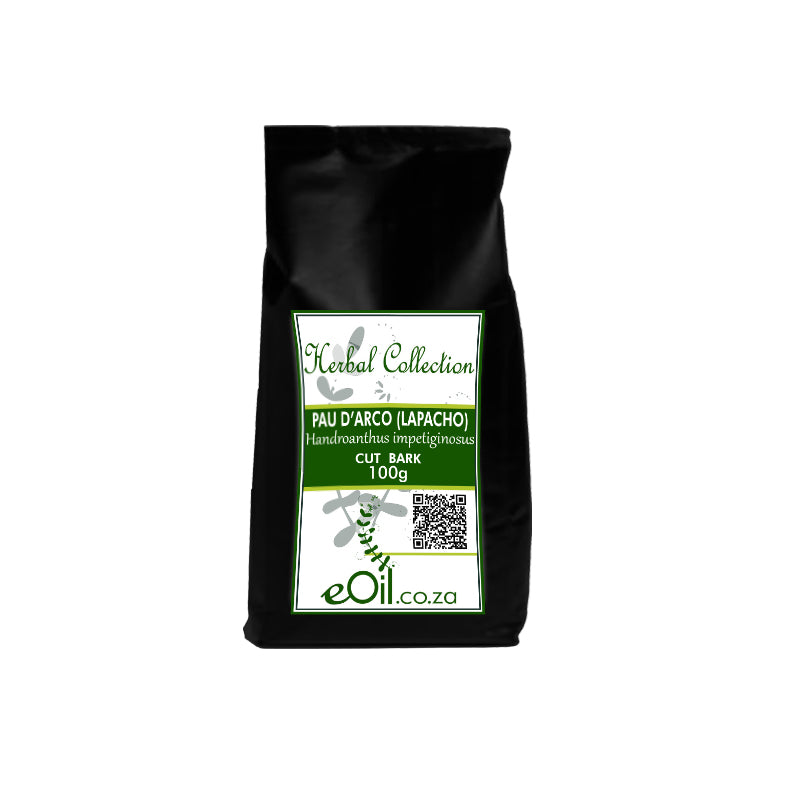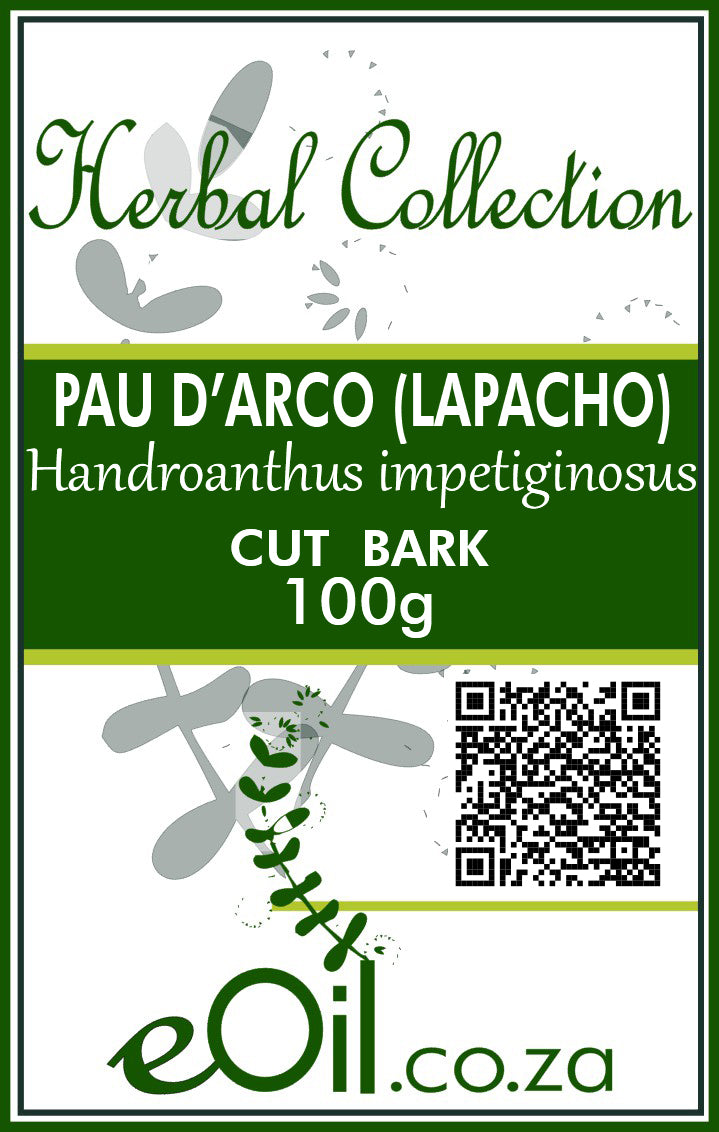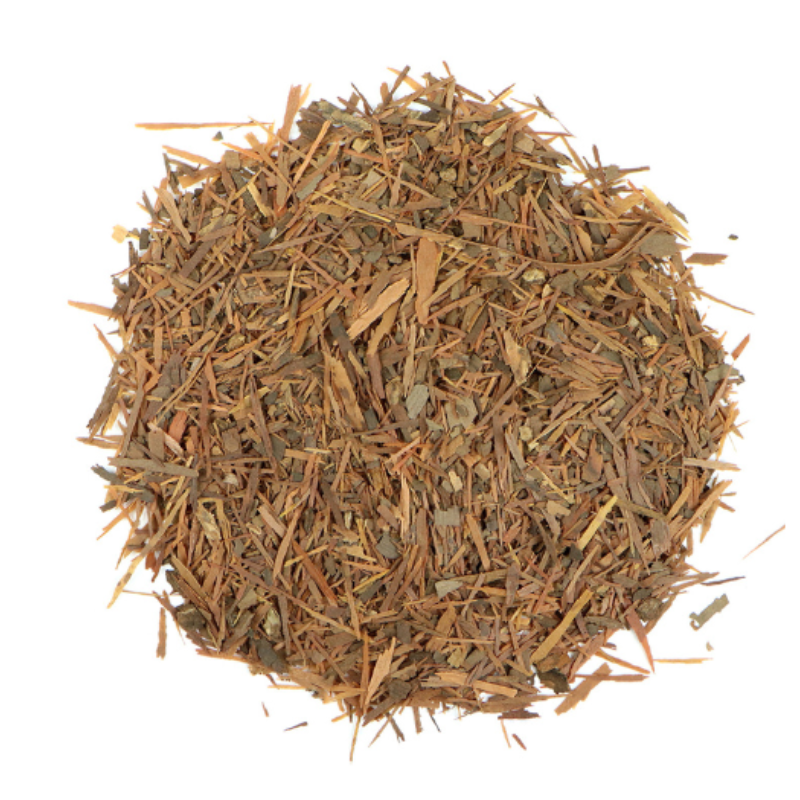Pau D'Arco Dried Bark Cut - Herbal Collection
Pau D'Arco Dried Bark Cut - Herbal Collection - 100 is backordered and will ship as soon as it is back in stock.
Description
Description
Pau D'Arco Dried (Tabebuiae impertiginosa) - 100 g - Herbal Collection
Pau d'Arco, derived from the inner bark of the Tabebuia impetiginosa tree, is a traditional herbal extract revered for its potential properties.
This natural extract contains various compounds, including lapachol and beta-lapachone, which have been studied for their potential benefits in maintaining overall well-being.
For in depth information check tabs below
TRADITIONALLY USED FOR
Pau d'Arco has a long history of traditional use in South America, where it is native.
Indigenous communities have used it for a variety of purposes, including:
1. Pau d'arco Information | Mount Sinai - New York
Pain relief: Pau d'Arco was used to alleviate pain associated with various conditions, such as arthritis, headaches, and muscle aches.
Fever reduction: It was often used as a natural remedy to lower fever and reduce associated symptoms.
1. How Pau D'arco Helps Fight Candida, Cancer and Inflammation - Dr. Axe
- Wound healing: The bark was applied topically to promote wound healing and prevent infections.
- Gastrointestinal issues: Pau d'Arco was used to address digestive problems like diarrhea, dysentery, and ulcers.
Respiratory ailments: It was employed to relieve coughs, bronchitis, and other respiratory issues.
1. Pau D'Arco: Herbal Uses, Warnings, Side Effects, Dosage - MedicineNet
- Skin conditions: Pau d'Arco was applied to the skin to treat various skin problems, including eczema, psoriasis, and fungal infections.
Infections: It was used to combat various infections, including those caused by bacteria, viruses, and parasites.
While these traditional uses have been passed down through generations, it is important to note that scientific evidence supporting the efficacy and safety of Pau d'Arco for these purposes is limited. Further research is needed to fully understand its potential benefits and risks.
It is always advisable to consult with a healthcare professional before using Pau d'Arco, especially if you are pregnant, breastfeeding, or have any underlying medical conditions.
INFORMATION
Source : http://www.wikiphyto.org/wiki/Pau d'arco
Reference on http://www.wikiphyto.org
Translation in English by Google Translate (go to the page of the source linked | on Chrome cellphones go on the 3 dots on the top right and select translate in your preferred language | on laptop right click your mouse and select option translate when hoovering on the page
plant name
Lapacho, Purple Ipe , Pau d'Arco
International Latin denomination
Handroanthus impetiginosus (Mart. ex DC.) Mattos; Tabebuia impetiginosa (Mart. ex DC.) Standi. and Tabebuia avellanedae Lorentz ex Griseb.
botanical family
Bignoniaceae
Description and habitat
- Tree from South America mountainous regions of the Peruvian and especially Argentinian Andes, also present in the tropical forests of Brazil and Paraguay
- Leaves deciduous, opposite, entire ovoid, large flowers, with marked tubular corolla and spreading lobes, red or purple, the fruit is a capsule
History and tradition
- The Incas used it to heal their wounds and to treat snakebites (alexitere plant, recommended against snakebites)
- It was a miracle drug for the Incas and Callawayas of Brazil, and has been part of the South American pharmacopoeia for centuries, healers use it as an anti-infective, antitumor, against diabetes, as an antidote to bites snakes and insect bites
- The wood of the tree was used in making bows (pau d'arco means "hunting bow" in some indigenous languages in Brazil)
- Pau d'Arco ( Tabebuia avellanedae ) is said to be the most active, but Lapacho ( Tabebuia impetiginosa ) is the most widespread
- Attention: it is not cultivated: the bark would be harvested from wild trees in the middle of the forest
Parts used
- Bark
Dosage forms available
Usual dosages
- Decoction: boil 15 to 20 g of dried inner bark (or powder), for 8 to 10 minutes, in 500 ml of water. Infuse 10 minutes, filter. Drink the quantity during the day (traditional preparation)
Composition
Main components of the plant
- Naphtoquinones : lapachol (quinone), désoxylapachol, alpha-lapachone et béta-lapachone
- Anthraquinones
- Coumarines
- Saponosides
- Flavonoids
- Diterpène (carnosol)
- Glycosides d'iridoïdes
- Phenylethanoids , phenylpropanoids [2] , [3]
Main components of buds or young shoots
Main components of essential oil
Properties
Plant properties
- Reputed to cure cancer [4] , [5] , [6] , especially with synthetic derivatives of naphthoquinones [7]
- Inhibitory effect on lymphocyte proliferation [8]
- Antibacterial ( Staphylococcus ) [9] , antiseptic, anti -Helicobacter pylori [10]
- Antioxidant [11] , by phenylpropanoids which show moderate inhibitory activity on cytochrome CYP3A4 [12]
- Antifungal ( Candida )
- Immune stimulant, antitumor, beta-lapachone would inhibit DNA-topoisomerase, and would inhibit the relication of HIV
- Antipsoriasique [13]
- Toning
- Anti-ulcer [14]
- Analgesic, anti-inflammatory [15] , antineoplastic, diuretic
Bud properties
Properties of essential oil
Indications
Indications of the whole plant (phytotherapy)
- Very prescribed in South America in viral or microbial infections (ENT, etc.)
- Leishmaniose (lapachol) [16]
- Malaria (?) [17]
- Canker sores, recurrences of herpes, chronic candidal mycoses
- Chronic fatigue syndrome
- Various inflammations (bladder, prostate, cervix, etc.)
- Psoriasis (?)
- Cancers, leukemias (?)
Indications of the bud (gemmotherapy)
Specific indications of essential oil (aromatherapy)
Known or suspected mode of action
- Beta -lapachone would inhibit DNA-topoisomerase, and inhibit HIV replication
- Naphthoquinones are fungicides and parasiticides and would explain the resistance of certain woods to xylophagous organisms (such as teak Tectona grandis , Verbenaceae )
Usual formulations
Regulations
Possible side effects and precautions for use
Bibliographic references
- Go↑ Grose, Susan O.; Olmstead, R.G. Taxonomic Revisions in the Polyphyletic Genus Tabebuia s. I. (Bignoniaceae). Systematic Botany, Volume 32, Number 3, July 2007 , pp. 660-670(11). http://cat.inist.fr/?aModele=afficheN&cpsidt=19052415
- Go↑ Tsutomu Warashina, Yoshimi Nagatani, Tadataka Noro. Constituents from the bark of Tabebuia impetiginosa. Phytochemistry, Volume 65, Issue 13, July 2004, Pages 2003-2011
- Go↑ Tsutomu Warashina, Yoshimi Nagatani, Tadataka Noro. Further constituents from the bark of Tabebuia impetiginosa. Phytochemistry, Volume 66, Issue 5, March 2005, Pages 589-597
- Go↑ Pablo H. Di Chenna, Violeta Benedetti-Doctorovich, Ricardo F. Baggio, M. Teresa Garland, Gerardo Burton. Preparation and Cytotoxicity toward Cancer Cells of Mono(arylimino) Derivatives of β-Lapachone. Journal of Medicinal Chemistry, 2001 44 (15), 2486-2489. PMID 11448231
- Go↑ Gómez Castellanos JR, Prieto JM, Heinrich M. Red Lapacho (Tabebuia impetiginosa)--a global ethnopharmacological commodity? J Ethnopharmacol. 2009 Jan 12;121(1):1-13. doi: 10.1016/j.jep.2008.10.004. PMID 18992801
- Go↑ de Melo JG, Santos AG, de Amorim EL, do Nascimento SC, de Albuquerque UP. Medicinal plants used as antitumor agents in Brazil: an ethnobotanical approach. Evid Based Complement Alternat Med. 2011;2011:365359. doi: 10.1155/2011/365359. PMID 21528006
- Go↑ Inagaki R, Ninomiya M, Tanaka K, Watanabe K, Koketsu M. Synthesis and cytotoxicity on human leukemia cells of furonaphthoquinones isolated from tabebuia plants. Chem Pharm Bull (Tokyo). 2013;61(6):670-3. PMID 23727782
- Go↑ Torsten Böhler, Jochen Nolting, Purevtseren Gurragcha, Adrian Lupescu, Hans-H. Neumayer, Klemens Budde, Nassim Kamar, Jochen Klupp. Tabebuia avellanedae extracts inhibit IL-2-independent T-lymphocyte activation and proliferation. Transplant Immunology, Volume 18, Issue 4, February 2008, Pages 319-323. PMID 18158117
- Go↑ Pereira EM, Machado Tde B, Leal IC, Jesus DM, Damaso CR, Pinto AV, Giambiagi-deMarval M, Kuster RM, Santos KR. Tabebuia avellanedae naphthoquinones: activity against methicillin-resistant staphylococcal strains, cytotoxic activity and in vivo dermal irritability analysis. Ann Clin Microbiol Antimicrob. 2006 Mar 22;5:5. PMID 16553949
- Go↑ Park BS, Lee HK, Lee SE, Piao XL, Takeoka GR, Wong RY, Ahn YJ, Kim JH. Antibacterial activity of Tabebuia impetiginosa Martius ex DC (Taheebo) against Helicobacter pylori. J Ethnopharmacol. 2006 Apr 21;105(1-2):255-62. PMID 16359837
- Go↑ Byeoung-Soo Park, Kwang-Geun Lee, Takayuki Shibamoto, Sung-Eun Lee Gary R. Takeoka. Antioxidant Activity and Characterization of Volatile Constituents of Taheebo (Tabebuia impetiginosa Martius ex DC). J. Agric. Food Chem., 2003, 51 (1), pp 295–300. PMID 12502424
- ↑Go to :12,0 et 12,1 Suo M, Ohta T, Takano F, Jin S. Bioactive phenylpropanoid glycosides from Tabebuia avellanedae. Molecules. 2013 Jun 24;18(7):7336-45. doi: 10.3390/molecules18077336. PMID 23797703
- Go↑ Klaus Müller, Andreas Sellmer, Wolfgang Wiegrebe. Potential Antipsoriatic Agents: Lapacho Compounds as Potent Inhibitors of HaCaT Cell Growth. J. Nat. Prod., 1999, 62 (8), pp 1134–1136. PMID 10479319
- Go↑ Pereira IT, Burci LM, da Silva LM, Baggio CH, Heller M, Micke GA, Pizzolatti MG, Marques MC, Werner MF. Antiulcer effect of bark extract of Tabebuia avellanedae: activation of cell proliferation in gastric mucosa during the healing process. Phytother Res. 2013 Jul;27(7):1067-73. doi: 10.1002/ptr.4835. PMID 22969019
- Go↑ Suo M, Isao H, Kato H, Takano F, Ohta T. Anti-inflammatory constituents from Tabebuia avellanedae. Fitoterapia. 2012 Dec;83(8):1484-8. doi: 10.1016/j.fitote.2012.08.014. PMID 22955001
- Go↑ Teixeira MJ, de Almeida YM, Viana JR, Holanda Filha JG, Rodrigues TP, Prata JR Jr, Coêlho IC, Rao VS, Pompeu MM. In vitro and in vivo Leishmanicidal activity of 2-hydroxy-3-(3-methyl-2-butenyl)-1,4-naphthoquinone (lapachol). Phytother Res. 2001 Feb;15(1):44-8. PMID 11180522
- Go↑ de Andrade-Neto VF, Goulart MO, da Silva Filho JF, da Silva MJ, Pinto Mdo C, Pinto AV, Zalis MG, Carvalho LH, Krettli AU. Antimalarial activity of phenazines from lapachol, beta-lapachone and its derivatives against Plasmodium falciparum in vitro and Plasmodium berghei in vivo. Bioorg Med Chem Lett. 2004 Mar 8;14(5):1145-9. PMID 14980653
- Go↑ Lemos OA, Sanches JC, Silva IE, Silva ML, Vinhólis AH, Felix MA, Santos RA, Cecchi AO. Genotoxic effects of Tabebuia impetiginosa (Mart. Ex DC.) Standl. (Lamiales, Bignoniaceae) extract in Wistar rats. Genet Mol Biol. 2012 Apr;35(2):498-502. doi: 10.1590/S1415-47572012005000030. PMID 22888300
- Gislene G. F. Nascimento, Juliana Locatelli, Paulo C. Freitas, Giuliana L. Silva. Antibacterial activity of plant extracts and phytochemicals on antibiotic- resistant bacteria. Brazilian Journal of Microbiology (2000) 31:247-256 [texte intégral : http://www.scielo.br/pdf/bjm/v31n4/a03v31n4.pdf]
- Hidayat Hussain, Karsten Krohn, Viqar Uddin Ahmad, Ghulam Abbas Miana, Ivan Robert Greend. Lapachol: an overview. Special Issue Reviews and Accounts ARKIVOC 2007 (ii) 145-171 (ISSN 1424-6376) [1]
- http://biotech.icmb.utexas.edu/botany/
- http://www.mmh-mms.com/downloads/mp19tmpabebuiaimpetiginosa.pdf
CAUTION
Store in a cool, dry place, away from light. Keep tightly closed, away from the reach of Children and pets.
Do not exceed the daily dose.
This product is not intended to prevent or cure any form of illness or disease.
If you are pregnant or nursing ; If you have a medical condition or are in the course of medical treatment ; If you are programmed for theater/operation in the near future, please consult your healthcare practitioner before using this product.
This product cannot replace a varied and balanced diet and a healthy lifestyle.
This product has not been evaluated by the SAHPRA for its quality, safety or intended use.
For More Information please check our General Safety Herbal products Page

Pau D'Arco Dried Bark Cut - Herbal Collection - 100 is backordered and will ship as soon as it is back in stock.





